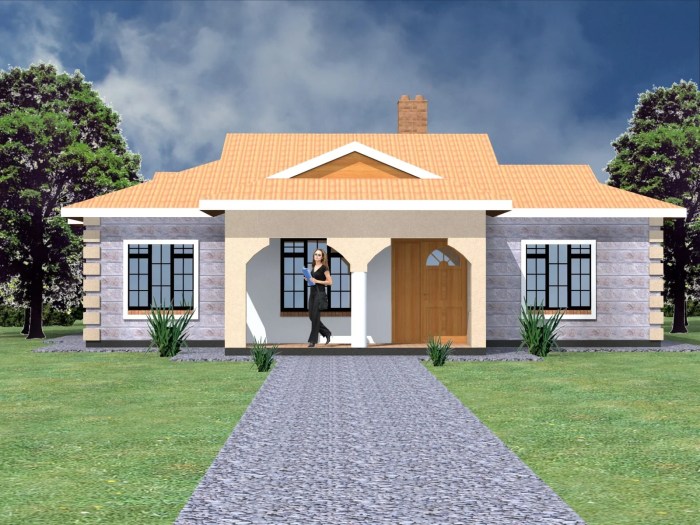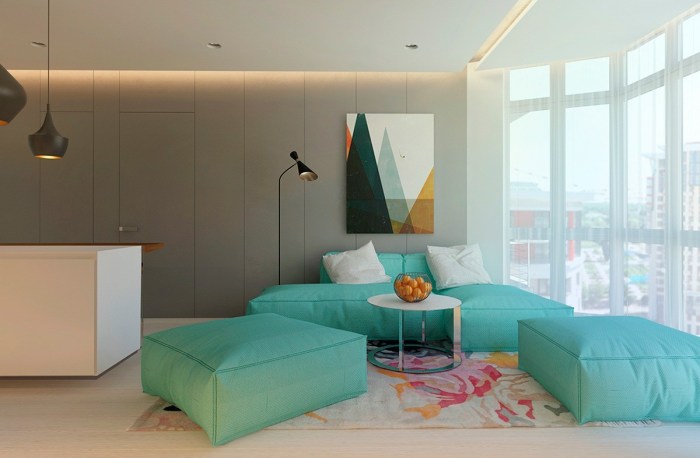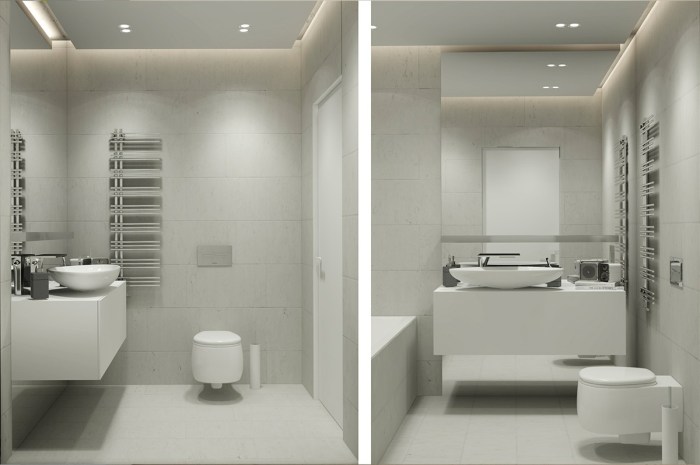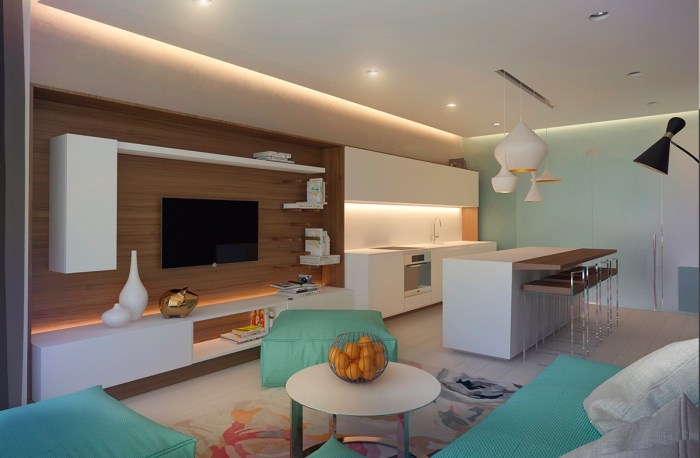The pursuit of serene living often leads to the exploration of minimalist design. Clean and simple home designs, far from being sterile, offer a pathway to tranquility and functionality. This approach prioritizes essential elements, utilizing space efficiently and creating an atmosphere of calm through thoughtful material selection and strategic lighting. We’ll delve into the core principles, practical applications, and aesthetic considerations that define this increasingly popular style, exploring how it balances form and function for a harmonious living environment.
From the strategic use of natural light to the careful curation of furniture and finishes, we’ll uncover the science behind creating a space that is both visually appealing and conducive to well-being.
This exploration will cover the defining characteristics of clean and simple design, examining architectural styles, color palettes, and the crucial role of natural light and ventilation. We will then move into practical considerations, such as space optimization techniques for small spaces, effective storage solutions, and the selection of sustainable and eco-friendly materials. Finally, we will illustrate the principles through examples, showcasing how clean and simple design can be adapted across various budgets and architectural styles.
Defining “Clean and Simple Home Designs”

Clean and simple home design prioritizes functionality, minimalism, and a sense of calm. It’s a philosophy that rejects clutter and ornamentation in favor of clean lines, neutral palettes, and a focus on quality materials. This aesthetic transcends fleeting trends, offering a timeless and adaptable approach to interior and exterior architecture.Clean and simple design isn’t about stark emptiness; rather, it’s about carefully curating elements to create a space that feels both spacious and intentional.
The goal is to maximize the feeling of openness and tranquility, reducing visual noise and promoting a sense of well-being. This approach draws upon principles of both modernism and minimalism, resulting in homes that are both visually appealing and highly functional.
Core Principles of Clean and Simple Design Aesthetics
The core principles of clean and simple home design revolve around several key elements. Firstly, minimalism dictates a reduction in the number of items and decorative elements within a space. This allows the inherent beauty of architectural lines and the chosen materials to take center stage. Secondly, functionality is paramount; every item serves a purpose, contributing to the overall efficiency and ease of use of the home.
Thirdly, a carefully chosen color palette, often featuring neutral tones, creates a cohesive and calming atmosphere. Finally, the strategic use of natural light and ventilation enhances the sense of spaciousness and well-being. These principles work synergistically to create homes that are both aesthetically pleasing and incredibly liveable.
Architectural Styles Embodying Clean and Simple Design
Several architectural styles exemplify the principles of clean and simple design. Mid-century modern architecture, with its emphasis on clean lines, open floor plans, and the integration of indoor and outdoor spaces, is a prime example. The clean geometry of its structures, often featuring large windows and simple facades, directly reflects the minimalist aesthetic. Similarly, Scandinavian design, characterized by its light, airy spaces, natural materials (like wood and stone), and a focus on functionality, perfectly embodies this style.
The minimalist approach of Japanese architecture, with its emphasis on natural light, clean lines, and the use of natural materials, also aligns strongly with clean and simple design principles. These styles showcase how diverse architectural traditions can converge on a shared emphasis on simplicity and functionality.
Color Palettes in Clean and Simple Home Designs
Color palettes in clean and simple home designs generally favor a neutral base. Shades of white, beige, gray, and off-white create a sense of spaciousness and serenity. These neutral tones serve as a backdrop for pops of color that are used sparingly and intentionally, often derived from nature, such as muted greens, blues, or earth tones. The limited color palette avoids visual clutter, promoting a sense of calm and focus.
For example, a living room might use a creamy white as the dominant color, complemented by muted blue accents in throw pillows and artwork, reflecting a serene coastal theme. This careful selection and limited application of color are crucial in reinforcing the overall clean and simple aesthetic.
The Role of Natural Light and Ventilation
Natural light and ventilation are integral to achieving a clean and simple feel. Large windows, strategically placed to maximize natural light, create a bright and airy atmosphere, visually expanding the space and minimizing the need for artificial lighting. Furthermore, proper ventilation, through the use of windows, skylights, or strategically placed vents, ensures a constant flow of fresh air, improving indoor air quality and creating a healthier and more comfortable living environment.
This combination of light and air significantly contributes to the overall sense of spaciousness and well-being that defines clean and simple home designs. Homes designed with this in mind often feel larger and more inviting than their square footage might suggest.
Space Optimization in Clean and Simple Homes

Clean and simple home design isn’t just about aesthetics; it’s fundamentally about maximizing functionality within available space. This approach, informed by principles of ergonomics and spatial psychology, leverages efficient layouts and smart storage solutions to create comfortable and uncluttered living environments, even in smaller homes. The key is to use every square foot purposefully, eliminating wasted space and promoting a sense of calm and order.
Effective space optimization in small spaces relies on a combination of strategic planning, mindful furniture selection, and a commitment to decluttering. By applying these principles, even the smallest apartment can feel spacious and inviting.
A Small Apartment Floor Plan
The following floor plan illustrates a 500 square foot apartment designed with clean and simple principles in mind. The focus is on maximizing natural light, creating a sense of flow, and incorporating versatile storage solutions. Imagine a rectangular space with the longest wall facing a window providing ample natural light.
| Room | Dimensions (ft) | Function | Notes |
|---|---|---|---|
| Living Room | 15 x 12 | Relaxation, entertaining | Includes built-in shelving |
| Kitchen | 8 x 10 | Cooking, dining | Compact, efficient layout |
| Bedroom | 10 x 10 | Sleeping, relaxing | Includes built-in wardrobe |
| Bathroom | 5 x 6 | Hygiene | Compact design, maximized storage |
Maximizing Storage in a Clean and Simple Home
Effective storage is crucial for maintaining a clean and simple aesthetic. Overcrowding visually clutters a space, negating the intended effect of a minimalist design. The following strategies help maximize storage capacity without compromising the clean lines of the design.
The principles of efficient storage hinge on utilizing vertical space, incorporating hidden storage, and employing multifunctional furniture. These approaches create a visually uncluttered environment while ensuring that belongings are easily accessible and organized.
- Utilize vertical space: Install tall bookshelves, utilize wall-mounted storage units, and consider loft beds to maximize vertical space.
- Incorporate hidden storage: Utilize ottomans with storage, beds with drawers, and cabinets that seamlessly integrate into the wall design.
- Employ multi-purpose furniture: Choose furniture that serves multiple functions, such as a sofa bed or a coffee table with built-in storage.
- Keep it minimal: Only keep items you truly need and use regularly. Regular decluttering prevents accumulation.
Multi-Functional Furniture for Clean and Simple Interiors
Multi-functional furniture is key to optimizing space in a clean and simple home. These pieces combine several functions into a single unit, saving valuable floor space and enhancing the overall aesthetic.
The selection of multifunctional furniture should prioritize pieces that integrate seamlessly into the overall design aesthetic, maintaining a sense of visual harmony and uncluttered space. Consider the materials and color palette to ensure consistency.
- Sofa beds: Provide seating during the day and a sleeping space at night.
- Coffee tables with storage: Offer a surface for drinks and storage for remotes or books.
- Ottomans with storage: Provide extra seating and hidden storage for blankets or games.
- Beds with built-in drawers: Maximize storage space under the bed.
The Importance of Decluttering
Decluttering is not merely about tidying; it’s a fundamental principle of clean and simple design. The accumulation of unnecessary items visually clutters a space, disrupting the sense of calm and order that characterizes a minimalist aesthetic.
Regular decluttering, viewed as an ongoing process rather than a one-time task, directly impacts the overall aesthetic of a clean and simple home. A space free from visual clutter promotes a sense of peace and well-being, enhancing the positive psychological impact of the design.
Studies have shown that a clutter-free environment reduces stress and improves focus. By regularly purging unnecessary items, you not only improve the visual appeal of your home but also contribute to a more peaceful and productive living environment.
Material Selection and Finishes

The choice of materials significantly impacts the aesthetic and environmental footprint of a clean and simple home. Prioritizing sustainable and durable materials not only enhances the visual appeal but also contributes to a healthier and more environmentally responsible living space. Careful consideration of material properties, such as longevity, recyclability, and embodied carbon, is crucial in achieving a truly clean and simple design.
Sustainable and Eco-Friendly Materials
Sustainable material selection is paramount in achieving a truly environmentally conscious clean and simple home. Many materials boast both aesthetic appeal and low environmental impact. Bamboo, for example, is a rapidly renewable resource offering a beautiful, durable alternative to hardwoods. Reclaimed wood, salvaged from demolition sites or old structures, reduces waste and adds character. Cork, a natural and biodegradable material, provides excellent insulation and a unique textural element.
Recycled glass and concrete contribute to circularity, while sustainably harvested timber certifications (like FSC) ensure responsible forestry practices. The use of low-VOC (volatile organic compound) paints and finishes minimizes indoor air pollution, contributing to a healthier living environment. These choices collectively reduce the home’s carbon footprint and promote responsible resource management.
Flooring Options for Clean and Simple Aesthetics
Hardwood, tile, and concrete represent popular flooring choices, each with distinct advantages and disadvantages within the context of clean and simple design. Hardwood floors, while classic and elegant, require more maintenance than other options and might not be suitable for all climates or lifestyles. Tile, particularly large-format porcelain tiles, offers durability, ease of cleaning, and a contemporary feel. Its versatility in color and texture allows for a wide range of design possibilities, aligning well with minimalist aesthetics.
Concrete flooring, known for its industrial chic appeal, offers exceptional durability and longevity, though it requires specific sealing and maintenance to prevent staining. The choice depends on factors such as budget, desired aesthetic, and lifestyle considerations.
Sample Materials Palette for a Clean and Simple Kitchen
The kitchen is a central space where material selection significantly influences the overall aesthetic. A carefully curated palette can create a harmonious and functional environment. The following is a sample materials palette for a clean and simple kitchen design:
- Countertops: Quartz or engineered stone. These materials offer durability, stain resistance, and a seamless, contemporary look. Their low maintenance requirements align with the clean and simple philosophy.
- Cabinets: Flat-panel cabinetry made from sustainably sourced wood (such as FSC-certified maple or birch) or high-quality, durable laminate. The absence of ornate details emphasizes the minimalist aesthetic.
- Backsplash: Large-format, matte white or light grey porcelain tiles. This creates a clean and uncluttered backdrop that complements the other elements without competing for attention.
Minimalist Hardware and Fixtures
Minimalist hardware and fixtures play a crucial role in achieving a clean and simple aesthetic. Streamlined, handleless cabinetry, integrated appliances, and simple faucets contribute to a sense of order and uncluttered space. The focus is on functionality and understated elegance, avoiding ornamentation or unnecessary detailing. Materials like brushed nickel, matte black, or polished chrome can be used sparingly to create subtle accents.
The absence of excessive detailing allows the architectural lines and material choices to take center stage. Choosing fixtures with a long lifespan and repairability aligns with the principles of sustainability and reduces the need for frequent replacements.
Lighting and Ambiance

The interplay of light and shadow is paramount in achieving a clean and simple aesthetic. Proper lighting design not only illuminates a space functionally but also shapes its mood, enhances its architectural features, and ultimately defines its overall ambiance. A thoughtfully planned lighting scheme can transform a minimalist interior from stark to inviting, highlighting the purity of form and material inherent in clean and simple design.
Understanding the different types of lighting and their applications is crucial to achieving this balance.The effective use of ambient, task, and accent lighting is key to creating a visually appealing and functional space within the clean and simple design philosophy. Ambient lighting provides overall illumination, task lighting focuses light on specific areas for activities, and accent lighting highlights architectural details or artwork.
The careful balance of these three types prevents the space from feeling either too harshly lit or insufficiently illuminated. This balanced approach directly supports the clean lines and uncluttered surfaces that define this design style.
Living Room Lighting Plan
A well-lit living room is the heart of a home, and in a clean and simple design, the lighting should reflect this centrality. The following plan emphasizes functionality and visual appeal, avoiding clutter and unnecessary visual distractions.
- Ambient Lighting: A recessed LED light panel in the ceiling provides even, soft illumination across the entire room. This minimizes shadows and creates a sense of spaciousness, perfectly complementing the minimalist aesthetic.
- Task Lighting: Two adjustable floor lamps, positioned near seating areas, provide focused light for reading or other activities. Their sleek, minimalist designs avoid visual clutter and complement the overall style.
- Accent Lighting: A single, linear LED strip light is subtly integrated beneath a floating shelf, highlighting the shelf’s clean lines and any displayed objects. This avoids the harshness of direct spotlights while providing a gentle glow.
Natural Light Integration
Natural light is a powerful design element, especially in clean and simple homes. Its integration with artificial lighting systems is crucial for creating a dynamic and energy-efficient environment. Maximizing natural light through large windows or skylights is a cornerstone of this approach. However, the intensity of natural light can vary significantly throughout the day, requiring a well-designed artificial lighting system to compensate.
This necessitates the use of dimmable lights and smart lighting systems that can adjust the artificial light levels in response to the available natural light, maintaining a consistent and comfortable ambiance. For example, during the day, the recessed LED panel in the living room can be dimmed, allowing natural light to be the primary source of illumination, while in the evening, it can be brightened to provide sufficient ambient lighting.
Bedroom Lighting Mood Board
This mood board illustrates three lighting scenarios in a clean and simple bedroom: relaxation, reading, and getting ready.
- Relaxation: The room is bathed in warm, low-level light from a single, centrally placed pendant light with a frosted glass shade. The walls are painted a soft, calming grey, and the bedding is a neutral beige linen. The overall texture is soft and inviting, enhancing the sense of tranquility. The light’s soft glow minimizes shadows, creating a soothing and peaceful atmosphere.
- Reading: A sleek, adjustable bedside lamp with a directed light provides focused illumination for reading. The lamp’s minimalist design complements the overall bedroom aesthetic. The walls are the same soft grey, but the bedding is complemented by a darker throw for contrast. The task lighting prevents eye strain while maintaining a subdued ambiance.
- Getting Ready: A full-length mirror is illuminated by two small, wall-mounted LED lights on either side, providing bright, even light for applying makeup or getting dressed. The lights are integrated seamlessly into the wall, avoiding visual clutter. The walls and bedding remain the same, but the lighting transforms the space into a functional area.
Illustrative Examples of Clean and Simple Home Designs
Clean and simple home design, characterized by its minimalist aesthetic and functional layout, translates into diverse and adaptable styles across various room types and budgets. The core principles—uncluttered spaces, neutral palettes, and high-quality materials—remain consistent, offering a versatile approach to interior design. This section provides concrete examples of how these principles manifest in different contexts.
Clean and Simple Design in Different Room Types
The application of clean and simple design principles varies depending on the room’s function. However, the underlying emphasis on functionality and visual calmness remains constant.
- Bathroom: A clean and simple bathroom might feature a floating vanity made of light-colored wood or sleek white lacquer, a frameless glass shower enclosure, and minimalist chrome fixtures. The color palette would typically be neutral, with accents of calming blues or greens. The space would be free of clutter, with storage integrated seamlessly into the design.
- Bedroom: A clean and simple bedroom emphasizes rest and relaxation. This is achieved through a neutral color palette (e.g., soft greys, whites, or beige), simple lines in the furniture (a platform bed with clean lines, for example), and minimal accessories. Natural materials like linen or cotton are often preferred for bedding and textiles.
- Living Room: In a living room, clean and simple design focuses on creating a comfortable yet uncluttered space. This could involve a neutral-toned sofa with clean lines, a simple coffee table made of natural wood or metal, and minimal decorative elements. Strategic lighting plays a key role in setting the ambiance.
Diverse Examples of Clean and Simple Home Designs
The following descriptions illustrate the versatility of clean and simple design.
- Image 1: This image depicts a modern living room with a predominantly white color palette. The furniture includes a light grey sofa, a low, rectangular coffee table made of light oak, and a simple, white rug. The walls are painted white, and large windows allow ample natural light to flood the space. The overall style is Scandinavian minimalist.
- Image 2: This image shows a minimalist bedroom with a muted grey and white color scheme. The bed is a simple platform bed with a light grey linen headboard. The floor is light-colored hardwood, and the walls are painted a soft white. The only accessories are a small bedside table and a simple floor lamp. The style is contemporary and emphasizes functionality.
- Image 3: This image showcases a small, but efficiently designed kitchen. The cabinetry is sleek and white, the countertops are a light grey quartz, and the backsplash is a simple white subway tile. Stainless steel appliances maintain a consistent, modern aesthetic. The overall feel is clean, efficient, and uncluttered, typical of a modern minimalist design.
Clean and Simple Designs Across Various Budgets
Clean and simple design is not inherently expensive. Cost-effective choices can be made without compromising the core principles.
- Budget-Friendly Options: Utilizing readily available materials like IKEA furniture, painting walls in neutral colors, and using affordable textiles like cotton can achieve a clean and simple look without significant cost. Prioritizing functionality over superfluous decoration is key.
- Mid-Range Options: Investing in higher-quality materials such as solid wood furniture or natural stone countertops can elevate the aesthetic while remaining within a mid-range budget. Careful selection of key pieces, rather than filling the space with numerous items, is crucial.
- High-End Options: High-end clean and simple designs often incorporate bespoke furniture, high-quality natural materials (e.g., marble, reclaimed wood), and sophisticated lighting fixtures. The emphasis remains on quality and simplicity, but the cost reflects the superior materials and craftsmanship.
Adapting Clean and Simple Design to Different Architectural Styles
The principles of clean and simple design can be successfully integrated into various architectural styles.
- Modern: Clean lines, minimalist furniture, and a neutral palette are naturally suited to modern architecture. The focus is on functionality and geometric precision.
- Traditional: Clean and simple design can soften the formality of traditional architecture by incorporating neutral colors, streamlined furniture, and minimal ornamentation. This approach maintains the architectural character while enhancing the sense of space and calmness.
- Farmhouse: Clean and simple design complements the rustic charm of farmhouse architecture by emphasizing natural materials like wood and stone, while keeping the overall aesthetic uncluttered and refined. The use of light, airy colors helps to balance the rustic elements.
Ultimately, clean and simple home design is not merely an aesthetic choice; it’s a holistic approach to living. By prioritizing functionality, sustainability, and a sense of calm, this design philosophy offers a pathway to a more mindful and enjoyable home environment. The careful consideration of space, light, and materials culminates in a living space that is not only visually appealing but also promotes well-being and a sense of serenity.
The principles explored here – from decluttering strategies to the strategic placement of lighting – empower homeowners to create a space that reflects their personal style while enhancing their quality of life.
Q&A
What are the drawbacks of a clean and simple home design?
While offering many benefits, a minimalist approach can sometimes feel stark or impersonal if not carefully executed. Overly simplistic designs may lack character or visual interest for some, and the emphasis on functionality might require a degree of discipline in maintaining order and minimizing clutter.
How can I incorporate clean and simple design into an existing home without a complete renovation?
Start by decluttering and organizing existing belongings. Introduce neutral color palettes through paint, textiles, and accessories. Replace bulky furniture with more streamlined pieces. Strategic lighting and the addition of plants can significantly enhance the clean and simple aesthetic without major structural changes.
Is clean and simple design suitable for families with children?
Absolutely! While it requires more effort in maintaining order, the principles of clean and simple design can be adapted to family life. Durable, easy-to-clean materials and multi-functional furniture are key. Designated storage solutions for toys and other items are essential for maintaining a sense of calm.
How much does it cost to implement a clean and simple design?
The cost varies greatly depending on the scale of the project and material choices. However, clean and simple design often prioritizes functionality over extravagance, making it possible to achieve a stylish and serene home on a variety of budgets. Choosing cost-effective materials and focusing on strategic improvements can significantly reduce expenses.